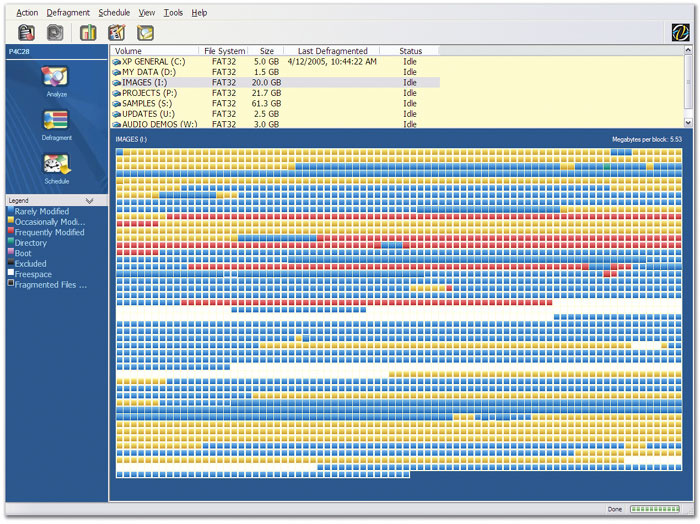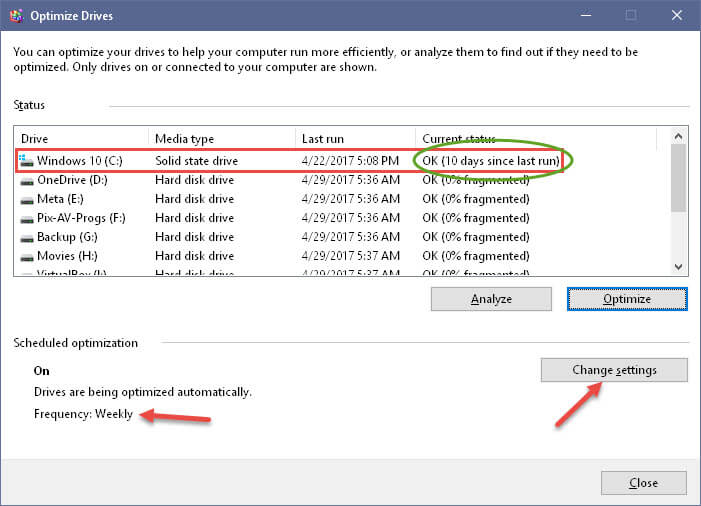

- #Windows disk defragmenter vs defraggler 2017 update#
- #Windows disk defragmenter vs defraggler 2017 full#
- #Windows disk defragmenter vs defraggler 2017 windows 10#
On checking back over my post, I got one thing the wrong way round - the PC snail pace resulted from the Microsoft Update 1709 - after roll-back to previous update, the PC speed was normal.
#Windows disk defragmenter vs defraggler 2017 full#
I only used the two basic options, Quick defrag or full defrag and let it do its own thing. I used no advanced options with Defraggler. Why do different defrag programs give different resultsĭelighted to get such a quick and well informed reply to my post. There's not much use using 2 one after the other, the second will just do its own thing and undo what the first one had done.Īs for why you ended up with more fragments after a full defrag with defraggler- did you use any advanced options?Įg, a minimum file size or 'Defrag Freespace - allow fragmentation' option? The main reason for using different ones is simply the User Interface. (that's with actual usage - not with using a different defragger to analyse in a different way). You won't be able tell any difference at all with actual computer usage. There is no one 'standard' way of doing it, that's why there are so many defragmenters to choose from.Ĭhoose whichever suits you.

is it better to have files in contiguous blocks, maybe with gaps between them on the disc, or better to fill the gaps in the disc and let files become 'split up' over disc clusters?ĭifferent developers will give different opinions, and the defrag programme they write will give different results.
#Windows disk defragmenter vs defraggler 2017 windows 10#
I did not carry out any further de-fragmenting and the PC is now running fine again.Ĭan anyone throw any light on this very odd sequence of events, as Defraggler does not seem to be performing correctly and the built-in Optimizer in Windows 10 seems to do the job far better?Īt this point, it would be hard to recommend Defraggler to anyone.ĭifferent defraggers work to different algorithms, any two developers will have their own ideas about which is the best way to defrag.Įg. I then ran the Windows 10 disk optimizer, which initially reported the drive was 26% fragmented, but after all the defrag multiple passes and re-allocating, reported just 1% fragmented - a fully acceptable level of fragmentation.įinally, I re-ran Defraggler analyser to check on the Windows 10 Optimizer result and the figures now reported by Defraggler were 115 fragmented files, 446 fragments and 12% fragmented drive? Rather confused by this and after running chkdsk.exe/f/r from command prompt, which reported no errors, I decided to run a full defrag with Defraggler, which took about 12 hours.Īt the end of this, re-analysis reported 5663 fragmented files, 21,954 fragments and 53% fragmented? However, the drive map looked much tidier. The PC was also operating at a snails pace, after the roll back, so I did a C Cleaner clean up and then ran Defraggler, as I had not de-fragmented for some time, (several months), Defraggler reported 9851 Fragmented files, 33815 Fragments and 23% fragmented.Īfter a Quick Defrag, I was left with 7412 fragmented files, 27417 fragments and the same 23% fragmented state. Hopefully Microsoft will sort out all the bugs one day.

So I rolled back to my earlier version of Windows 10, for the time being, as it was problem free. You can certainly run a disk defragmentation if you like, but you typically don't see a performance gain due to using the built in and or third party disk based defragmentation tools.I carried out the latest Windows 10 fall creators update 1709 on my PC and encountered numerous issues, just like many other people. In addition disk based defragmentation shouldn't be necessary on the drives containing the *.EDB files because Microsoft extends the Exchange databases in various sized chunks, therefore the Exchange databases are usually not fragmented enough to warrant a defragmentation of the file system itself. Doing so speeds up the operation of products because the files can be accessed in a more efficient manner. GOexchange EDB repair can repair errors and warnings, fix minor inconsistencies, consolidate white space, rebuild the database itself, and ensure that group collaboration objects like mail, tasks, calendar and other items are optimized and in-tact.ĭisk based defragmentation tools focus on ensuring files are laid out across a disk in a contiguous fashion. GOexchange works with expert knowledge and consistency at the database level. The built in Windows defragmenter, Diskeeper and other third party disk defragmentation utilities accomplish totally different results then those achieved by GOexchange EDB repair.įirst, it's important to understand that GOexchange is much more than a defragmentation tool.

Modified on: Sat, 22 Apr, 2017 at 4:53 PM Microsoft Tools Does Windows Disk Defragmenter or Diskeeper accomplish the same things GOexchange does?


 0 kommentar(er)
0 kommentar(er)
